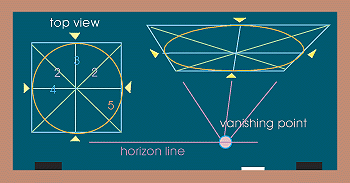
- Begin by creating a square in perspective. Look carefully to make sure that the form that you are creating in perspective is a square and not an elongated rectangle. Both right and left edges should recede back to the vanishing point on the horizon line.
- Subdivide the square by drawing a line fron corner to corner, then repeat this process with the opposite two corners. The point where the diagonal lines intersect will be the center of the square in perspective. The center should appear to be closer to the back edge than the front because size diminishes as things get further away from the viewer.
- Draw a line from the vanishing point through the center point until it reaches the back of the square. This will subdivide the square into halves.
- Draw a horizontal line through the center point which intersects the sides of the square. This subdivides the square further.
- Using the points where the subdivision lines meet the edges of the square, draw an oval whose furthest extensions are at the center of each flat side of the square. This oval will be somewhat smaller at the back of the square. Allow your drawing lines to create a flow, as if the line does not stop at each point, but continues unimpeded.
For best results, combine this process with observation of a circle in perspective.
A good example of circles in perspective occurs in the work of Giorgio di Chirico's Uncertainty of the Poet from 1913. The tops of the doorways on the right are lined up along a convergence line. The doorways are good examples of semi-circles drawn in perspective.